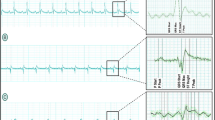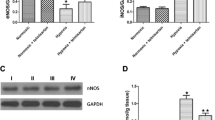Abstract
The experimental myocardial infarction (MI) model originating from isoproterenol (ISO) is frequently preferred in research due to its similarity to MI-induced damage in humans. Beneficial effects of L-arginine (L-Arg), a semi-essential amino acid, in cardiovascular diseases have been shown in many studies. This study was carried out to determine whether L-Arg pre-intervention has protective effects on heart tissue in the experimental MI model. The 28 rats used in the study were randomly divided into 4 equal groups: control, L-Arg, ISO, and L-Arg+ISO. Upon completion of all applications, cardiac markers in serum and biochemical, histopathological, and immunohistochemical examinations in cardiac tissues were performed. Cardiac markers, histopathological changes, oxidative stress, inflammation, and apoptosis were increased in the experimental MI model. In addition, administration of ISO deregulated OTULIN levels and mitochondrial dynamics in heart tissue. However, L-Arg pre-intervention showed a significant protective effect against changes in ISO-induced MI. L-Arg supplementation with cardioprotective effect may reduce the risks of possible pathophysiological processes in MI.






Similar content being viewed by others
Data Availability
The datasets generated during and/or analyzed during the current study are available from the corresponding author on reasonable request.
References
Abukhalil MH, Hussein OE, Aladaileh SH, Althunibat OY, Al-Amarat W et al (2021) Visnagin prevents isoproterenol-induced myocardial injury by attenuating oxidative stress and inflammation and upregulating Nrf2 signaling in rats. J Biochem Mol Toxicol 35(11):e22906
Althunibat OY, Abduh MS, Abukhalil MH, Aladaileh SH, Hanieh H, Mahmoud AM (2022) Umbelliferone prevents isoproterenol-induced myocardial injury by upregulating Nrf2/HO-1 signaling, and attenuating oxidative stress, inflammation, and cell death in rats. Biomed Pharmacother 149:112900
Annibaldi A, Meier P (2018) Checkpoints in TNF-induced cell death: implications in inflammation and cancer. Trends Mol Med 24:49–65
Atawia RT, Bunch KL, Toque HA, Caldwell RB, Caldwell RW (2019) Mechanisms of obesity-induced metabolic and vascular dysfunctions. Front Biosci (Landmark edition) 24:890
Buckley LF, Abbate A (2018) Interleukin-1 blockade in cardiovascular diseases: a clinical update. Eur Heart J 39(22):2063–2069
Chen J, Simmen T (2022) LUBAC and NF-κB trigger a nuclear response from mitochondria. EMBO J 41(24):e112920
Cheng L, Jin Z, Zhao R, Ren K, Deng C, Yu S (2015) Resveratrol attenuates inflammation and oxidative stress induced by myocardial ischemia-reperfusion injury: role of Nrf2/ARE pathway. Int J Clin Exp Med 28(7):10420
Chistiakov DA, Shkurat TP, Melnichenko AA, Grechko AV, Orekhov AN (2018) The role of mitochondrial dysfunction in cardiovascular disease: a brief review. Ann Med 50:121–127
Damgaard RB, Elliott PR, Swatek KN et al (2019) OTULIN deficiency in ORAS causes cell type-specific LUBAC degradation, dysregulated TNF signalling and cell death. EMBO Mol Med 11:e9324. https://doi.org/10.15252/emmm.201809324
Damgaard RB, Jolin HE, Allison MED et al (2020) OTULIN protects the liver against cell death, inflammation, fibrosis, and cancer. Cell Death Differ 27:1457–1474. https://doi.org/10.1038/s41418-020-0532-1
Darband SG, Sadighparvar S, Yousefi B et al (2020) Combination of exercise training and L-arginine reverses aging process through suppression of oxidative stress, inflammation, and apoptosis in the rat heart. Pflugers Arch - Eur J Physiol 472:169–178. https://doi.org/10.1007/s00424-019-02311-1
George MJ, Kleveland O, Garcia-Hernandez J et al (2020) Novel insights into the effects of interleukin 6 antagonism in non–ST-segment–elevation myocardial infarction employing the SOMA scan proteomics platform. J Am Heart Assoc 9(12):e015628
Gianazza E, Brioschi M, Fernandez AM, Banfi C (2019) Lipoxidation in cardiovascular diseases. Redox Biol 23:101119
Hayden MS, Ghosh S (2014) Regulation of NF-kappaB by TNF family cytokines. Semin Immunol 26:253–266
Heger K, Wickliffe KE, Ndoja A, Zhang J, Murthy A, Dugger DL et al (2018) OTULIN limits cell death and inflammation by deubiquitinating LUBAC. Nature 559:120–124. https://doi.org/10.1038/s41586-018-0256-2
Hoste E, Lecomte K, Annusver K, Vandamme N, Roels J, Maschalidi S et al (2021) OTULIN maintains skin homeostasis by controlling keratinocyte death and stem cell identity. Nat Commun 12:5913. https://doi.org/10.1038/s41467-021-25944-2
Islam D, Banerjee Shanta M, Akhter S et al (2020) Cardioprotective effect of garlic extract in isoproterenol-induced myocardial infarction in a rat model: assessment of pro-apoptotic caspase-3 gene expression. Clin Phytosci 6(1):1–9
Kaya S, Yalçın T, Boydak M, Dönmez HH (2023a) Protective effect of N-acetylcysteine against aluminum-induced kidney tissue damage in rats. Biol Trace Elem Res 201(4):1806–1815
Kaya S, Yalçın T, Kuloğlu T (2023b) Resveratrol may reduce oxidative stress and apoptosis in doxorubicin-induced cardiotoxicity by regulating meteorin-like and TRPM2 levels. Comp Clin Pathol 32:393–404. https://doi.org/10.1007/s00580-023-03449-2
Khalaf D, Krüger M, Wehland M, Infanger M, Grimm D (2019) The effects of oral l-arginine and l-citrulline supplementation on blood pressure. Nutrients 11(7):1679
Khan V, Hassan MQ, Akhtar M, Najmi AK (2018) Renin inhibition by aliskiren protects rats against isoproterenol induced myocardial infarction. Drug Research 68(03):139–145
Kulkarni PG, Mohire VM, Bhaisa PK, Joshi MM, Puranik CM, Waghmare PP, Banerjee T (2023) Mitofusin-2: functional switch between mitochondrial function and neurodegeneration. Mitochondrion 69:116–129
Li M, Tan H, Gao T et al (2022) Gypensapogenin I ameliorates isoproterenol (ISO)-induced myocardial damage through regulating the TLR4/NF-κB/NLRP3 pathway. Molecules 27(16):5298
Liang M, Wang Z, Li H, Cai L, Pan J, He H, Wu Q, Tang Y, Ma J, Yang L (2018) L-arginine induces antioxidant response to prevent oxidative stress via stimulation of glutathione synthesis and activation of Nrf2 pathway. Food Chem Toxicol 115:315–328
Ma D, Zheng B, Du H et al (2020) The mechanism underlying the protective effects of tannic acid against isoproterenol-induced myocardial fibrosis in mice. Front Pharmacol 11:716
Mahmoud AH, Taha NM, Zakhary M, Tadros MS (2019) PTEN gene & TNF-alpha in acute myocardial infarction. IJC Heart Vasc 23:100366
Meng Q, Cooney M, Yepuri N, Cooney RN (2017) L-arginine attenuates interleukin-1β (IL-1β) induced nuclear factor kappa-beta (NF-κB) activation in Caco-2 cells. PLoS One 12(3):e0174441. https://doi.org/10.1371/journal.pone.0174441
Newton K, Gitlin AD (2022) Deubiquitinases in cell death and inflammation. Biochem J 479(10):1103–1119
Othman AI, Elkomy MM, El-Missiry MA, Dardor M (2017) Epigallocatechin-3-gallate prevents cardiac apoptosis by modulating the intrinsic apoptotic pathway in isoproterenol-induced myocardial infarction. Eur J Pharmacol 794:27–36
Ozcan Yildirim S, Colakoglu N, Ozer Kaya S (2022) Protective effects of L-arginine against aluminium chloride-induced testicular damage in rats. Andrologia 54(11):e14569
Peng W, Cai G, Xia Y et al (2019) Mitochondrial dysfunction in atherosclerosis. DNA Cell Biol 38(7):597–606
Qin L, Yang W, Wang YX, Wang ZJ, Li CC, Li M et al (2018) MicroRNA-497 promotes proliferation and inhibits apoptosis of cardiomyocytes through the downregulation of Mfn2 in a mouse model of myocardial ischemia-reperfusion injury. Biomed Pharmacother 105:103–114
Rong N, Yang R, Ibrahim IAA, Zhang W (2023) Cardioprotective role of scopoletin on isoproterenol-induced myocardial infarction in rats. Appl Biochem Biotechnol 195(2):919–932
Salmani M, Alipoor E, Navid H, Farahbakhsh P, Yaseri M, Imani H (2021) Effect of L-arginine on cardiac reverse remodeling and quality of life in patients with heart failure. Clin Nutr 40(5):3037–3044
Schunke H, Gobel U, Dikic I, Pasparakis M (2021) OTULIN inhibits RIPK1-mediated keratinocyte necroptosis to prevent skin inflammation in mice. Nat Commun 12:5912. https://doi.org/10.1038/s41467-021-25945-1
Shahzad S, Hasan A, Faizy AF, Mateen S, Fatima N, Moin S (2018) Elevated DNA damage, oxidative stress, and impaired response defense system inflicted in patients with myocardial infarction. Clin Appl Thromb Hemost 24(5):780–789
Shen T, Zheng M, Cao C et al (2007) Mitofusin-2 is a major determinant of oxidative stress-mediated heart muscle cell apoptosis. J Biol Chem 282(32):23354–23361
Tripathi P, Pandey S (2013) L-arginine attenuates oxidative stress condition during cardiomyopathy. Indian J Biochem Biophys 50(2):99–104
Tur J, Pereira-Lopes S, Vico T, Marin EA, Munoz JP, Hernandez-Alvarez M, Cardona PJ, Zorzano A, Lloberas J, Celada A (2020) Mitofusin 2 in macrophages links mitochondrial ROS production, cytokine release, phagocytosis, autophagy, and bactericidal activity. Cell Rep 32:108079
Verboom L, Martens A, Priem D et al (2020) OTULIN prevents liver inflammation and hepatocellular carcinoma by inhibiting FADD- and RIPK1 kinase-mediated hepatocyte apoptosis. Cell Rep 30:2237–2247. https://doi.org/10.1016/j.celrep.2020.01.028
Vianna LC, Fernandes IA, Barbosa TC, Amaral TG, Rocha NG, Secher NH, Nobrega AC (2018) Absent increase in vertebral artery blood flow during L-arginine infusion in hypertensive men. Am J Phys Regul Integr Comp Phys 315(4):R820–R824
Wu Z, Berlemann LA, Bader V, Sehr DA, Dawin E, Covallero A et al (2022) LUBAC assembles a ubiquitin signaling platform at mitochondria for signal amplification and transport of NF-κB to the nucleus. EMBO J 41(24):e112006
Yalçın T, Kaya S (2023) Thymoquinone may alleviate cisplatin-induced muscle atrophy in rats by regulating mitofusin 2 and meteorin-like levels. Comp Clin Pathol 32:339–345. https://doi.org/10.1007/s00580-023-03442-9
Yalçın T, Kaya S, Kuloğlu T, Yiğin A (2023) N-acetylcysteine may regulate altered meteorin-like levels in testicular tissue due to aluminum exposure. Biolog Trace Elem Res:1–11
Ying L, Zhao GJ, Wu Y, Ke HL, Hong G, Zhang H et al (2017) Mitofusin 2 promotes apoptosis of CD4(+) T cells by inhibiting autophagy in sepsis. Mediat Inflamm 2017:5. https://doi.org/10.1155/2017/4926205
Youle RJ, van der Bliek AM (2012) Mitochondrial fission, fusion, and stress. Science 337(6098):1062–1065. https://doi.org/10.1126/science.1219855
Zervopoulos SD, Boukouris AE, Saleme B, Haromy A, Tejay S, Sutendra G, Michelakis ED (2022) MFN2-driven mitochondria-to-nucleus tethering allows a non-canonical nuclear entry pathway of the mitochondrial pyruvate dehydrogenase complex. Mol Cell 82:1066–1077
Zhou Q, Song J, Wang Y, Lin T (2020) Remifentanil attenuates cardiac dysfunction, lipid peroxidation and immune disorder in rats with isoproterenol-induced myocardial injury via JNK/NF-KB p65 inhibition. Annals Transl Med 8(8)
Zinngrebe J, Moepps B, Monecke T, Gierschik P, Schlichtig F, Barth TFE et al (2022) Compound heterozygous variants in OTULIN are associated with fulminant atypical late-onset ORAS. EMBO Mol Med 14:e14901. https://doi.org/10.15252/emmm.202114901
Author information
Authors and Affiliations
Contributions
All authors contributed to the understanding and design of the study. The implementation of the experimental procedure, material preparation, laboratory studies, data collection, and analysis were carried out by Sercan Kaya and Tuba Yalçın. All authors have read and approved the final article.
Corresponding author
Ethics declarations
Ethical approval
This study has been approved by the decision of Fırat University Animal Experiments Local Ethics Committee with the number 9555 and dated 08.07.2022.
Competing interests
The authors declare no competing interests.
Additional information
Publisher’s Note
Springer Nature remains neutral with regard to jurisdictional claims in published maps and institutional affiliations.
Rights and permissions
Springer Nature or its licensor (e.g. a society or other partner) holds exclusive rights to this article under a publishing agreement with the author(s) or other rightsholder(s); author self-archiving of the accepted manuscript version of this article is solely governed by the terms of such publishing agreement and applicable law.
About this article
Cite this article
Kaya, S., Yalcın, T. In an experimental myocardial infarction model, L-arginine pre-intervention may exert cardioprotective effects by regulating OTULIN levels and mitochondrial dynamics. Cell Stress and Chaperones 28, 811–820 (2023). https://doi.org/10.1007/s12192-023-01373-6
Received:
Revised:
Accepted:
Published:
Issue Date:
DOI: https://doi.org/10.1007/s12192-023-01373-6




